Estimated reading time: 5 minutes
Do fruit trees and frost go together?
The question of frost is often on people’s minds as they’re trying to decide which fruit trees to plant in their garden. We’ve had the first few frosty mornings here on the farm, so it’s a good time to clarify the question.
Related Articles
How to avoid leaf curl by watching for spring
Learning how to avoid leaf curl is all in the timing. The key time to pay attention is very early spring, earlier than you think!
Growing fruit trees for free by root grafting
Did you know you can grow a whole new fruit tree from a piece of root, using a simple technique called root grafting?
Winter and water for fruit trees
Do your fruit trees need water in winter? Understanding the impact of a wet winter will help you plan for summer.
Related Articles
How to avoid leaf curl by watching for spring
Learning how to avoid leaf curl is all in the timing. The key time to pay attention is very early spring, earlier than you think!
Growing fruit trees for free by root grafting
Did you know you can grow a whole new fruit tree from a piece of root, using a simple technique called root grafting?
Winter and water for fruit trees
Do your fruit trees need water in winter? Understanding the impact of a wet winter will help you plan for summer.
The first thing you need to know is that winter frosts are not a problem for fruit trees.
In fact, most deciduous fruit trees need a certain predetermined number of hours of cold each year to help them set fruit. This is called the chill factor and is a separate issue from frost.
When is frost a problem for your fruit trees?
Frost is only a problem for your trees in spring. Even then, the potential problem only occurs if there’s a frost when the trees are actually flowering, or when the fruit is tiny just after flowering.
Just because there’s a frost, doesn’t necessarily mean your trees will be damaged. Your crop might be affected, but it might not!

However, it’s certainly true that frost is more likely to damage some fruit trees than others. The hierarchy of frost-sensitive fruit trees is:
- almonds and apricots are the most frost-sensitive, then
- cherries (except they flower quite late, so there’s a better chance the frost risk will have passed)
- peaches and nectarines,
- apples,
- plums, and
- pears.
How do you know if your fruit trees have been frost damaged?
Just because apples, plums, and pears are at the bottom of the list doesn’t mean they can’t get frost damage. They most definitely can.
This is a photo of a typical ‘frost ring’ on an apple – damage caused by a frost when the tree was flowering.
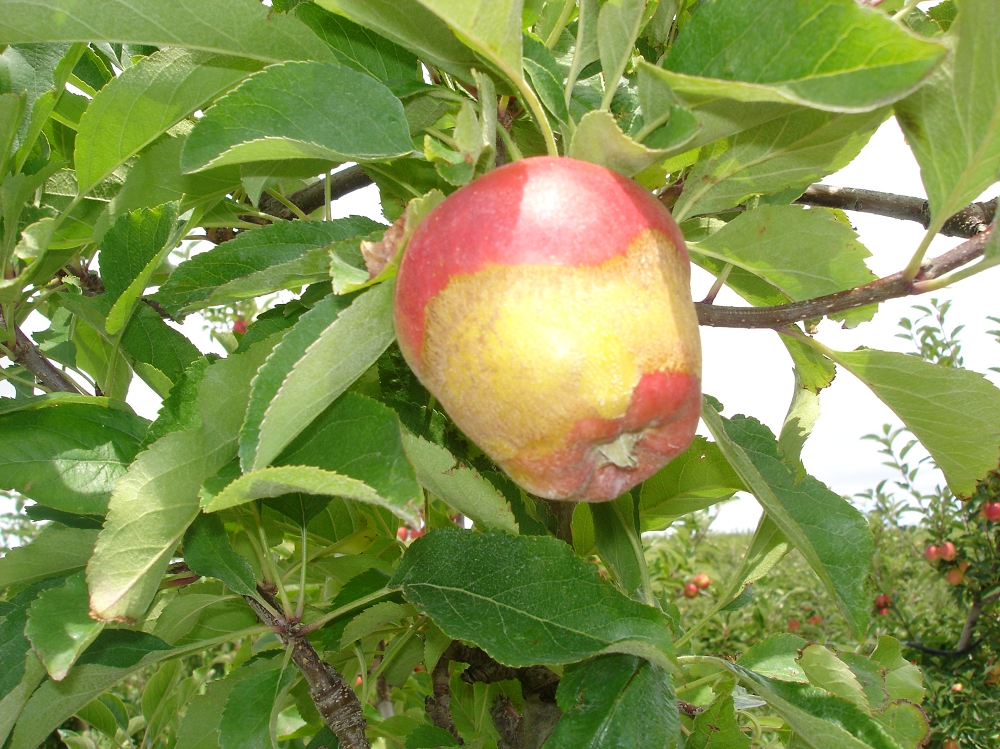
You’re likely to see damaged leaves on your fruit trees as another type of frost damage. This can be one of the many reasons that fruit tree leaves turn yellow, but they’ll usually turn black and may look burnt.
You may also see frost-burned blossom. Mild damage will usually cause brown margins (as you can see below). More serious damage will look darker and more of the flowers will be affected.
Unfortunately, they’ll probably shrivel up and fall off.
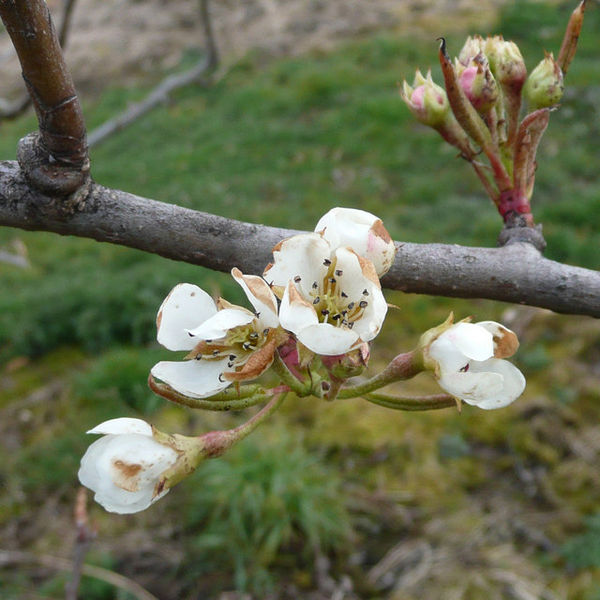
If you get bad frosts and don’t have a way to protect your fruit trees in spring, there’s a good chance you’ll have trouble growing apricots. That’s because they flower early and are susceptible, so the flowers will be burnt off by the frost.
This is actually one of the reasons why apricot trees are often so big. If they lose their crop to frost, they then put all their energy into growing wood instead of fruit. You can end up with a very large tree!
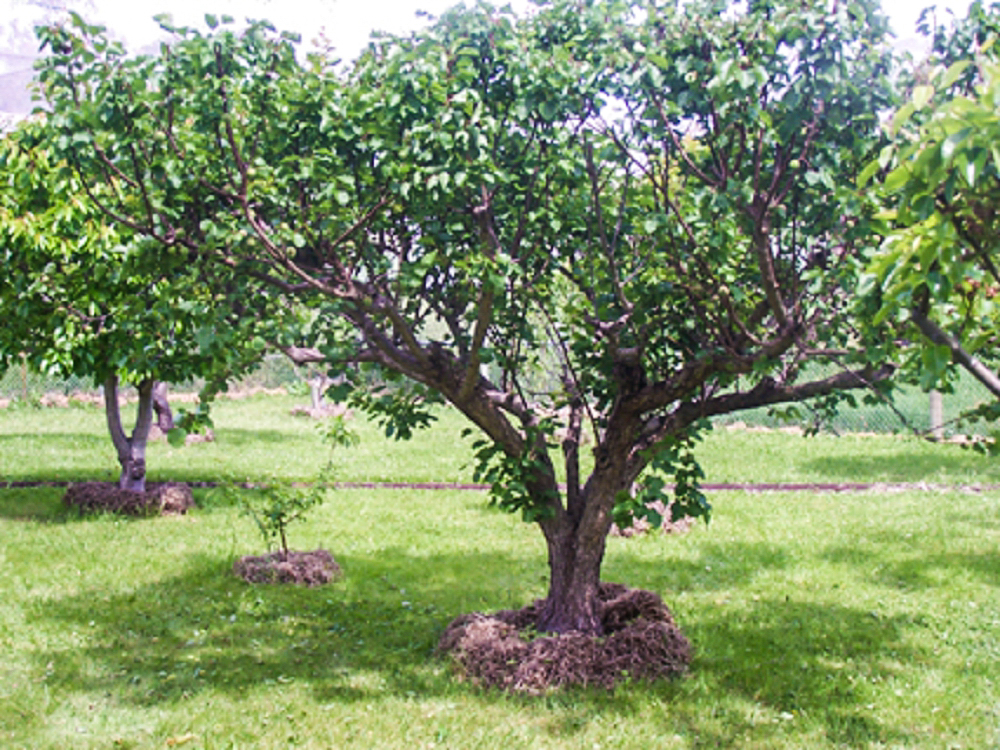
Protecting your trees
First, it’s important to know how frosty your place is. Where are the most vulnerable spots?
The next time you have a frosty morning, head outside nice and early in the dressing gown and gumboots. Have a really look at exactly where the frost is lying.
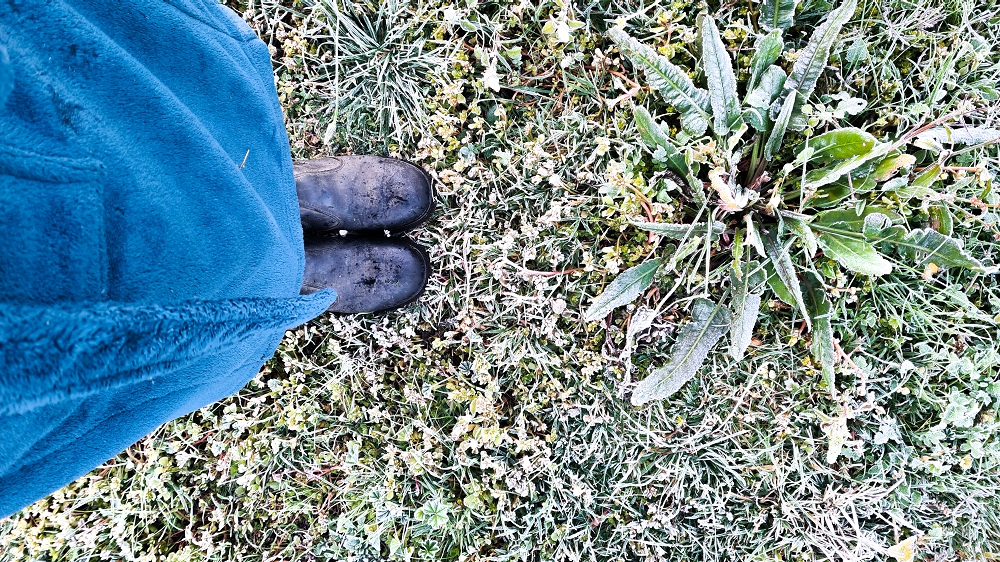
Then, try to match the trees you’d like to grow to the available micro-climates. Save the least frost-affected spots for the most frost-vulnerable trees.
Next, think about how you can create or enhance the microclimates. You can do this with plantings or infrastructure to create protected pockets.
Other things you can do include:
- Planting the most sensitive fruit trees in pots so you can shift them to protected spots in spring;
- When frost threatens, use frost cloth (or even old sheets) but remember to remove it the next morning.
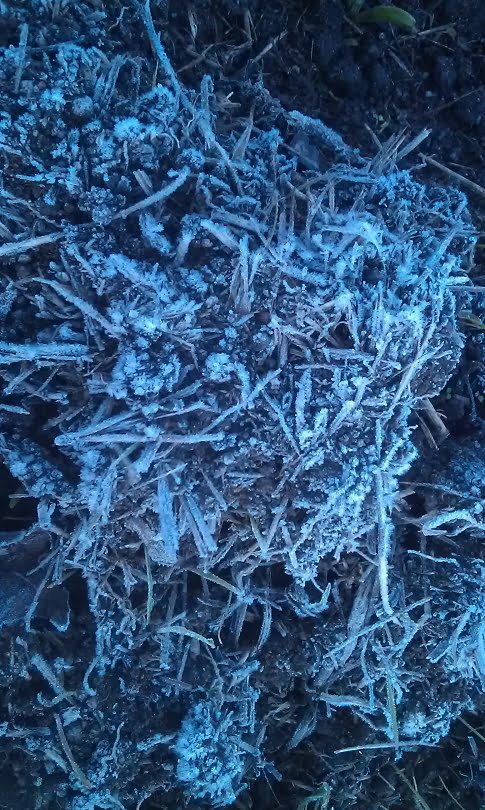
There are actually quite a lot of options available to you. It’s really surprising just how much you can do to provide the right habitat for lots of different fruit trees, even if they’re a bit outside their normal comfort zone.
This avocado tree is a great example. It’s absolutely thriving in a climate that is supposedly too cold. It’s been planted in a purpose-built north-facing suntrap, and it’s worked a treat.
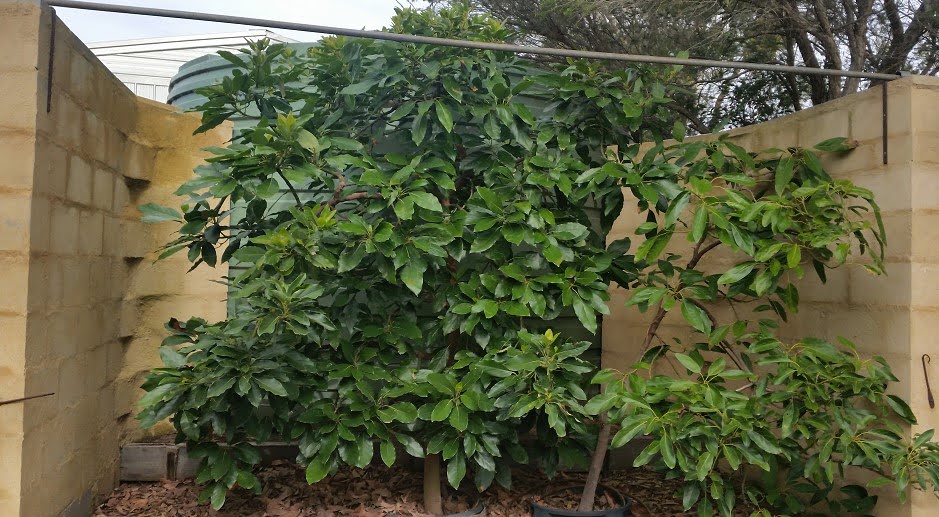
Related Articles
How to avoid leaf curl by watching for spring
Learning how to avoid leaf curl is all in the timing. The key time to pay attention is very early spring, earlier than you think!
Growing fruit trees for free by root grafting
Did you know you can grow a whole new fruit tree from a piece of root, using a simple technique called root grafting?
Winter and water for fruit trees
Do your fruit trees need water in winter? Understanding the impact of a wet winter will help you plan for summer.
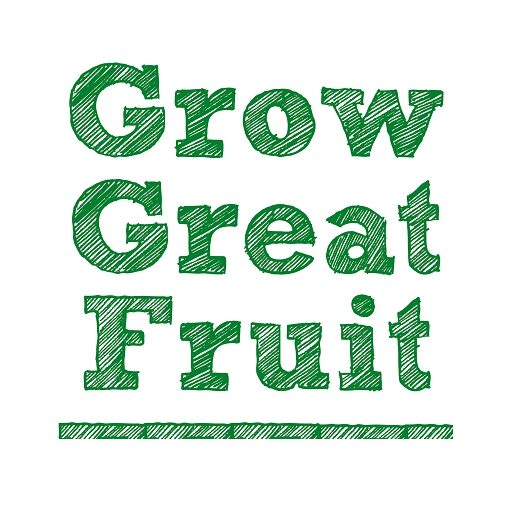
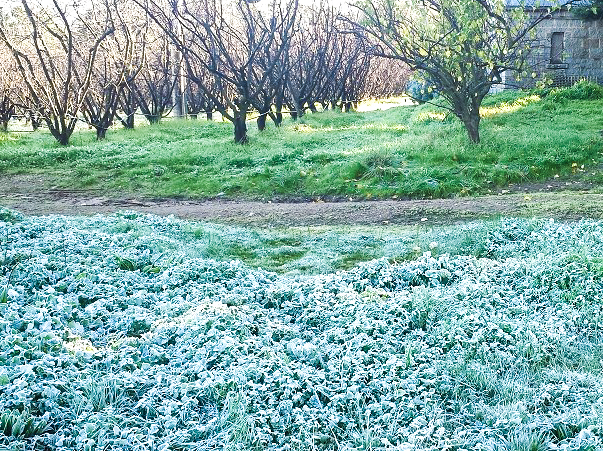

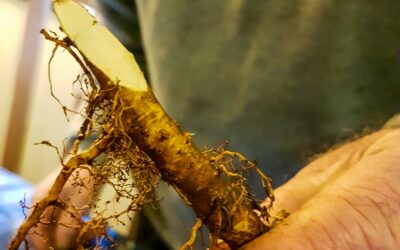
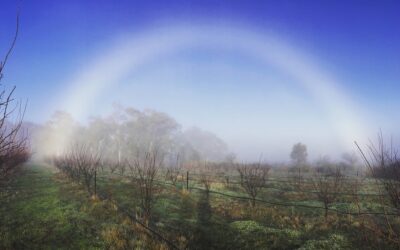
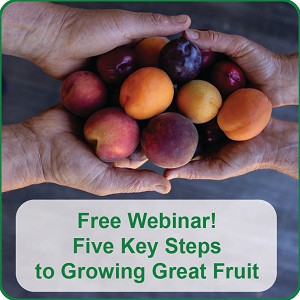
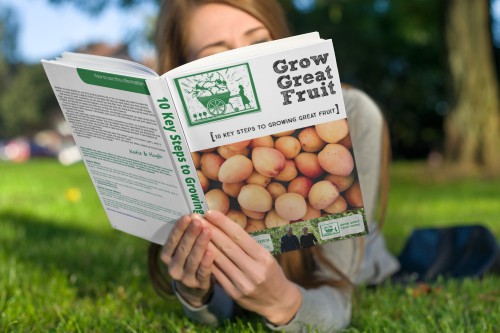
This was so helpful! Thank you!
Our pleasure Wendy, glad it was useful.
Thank you so much for that great lesson on Fruit trees snd Frost. Very good!!!
Buddy Paris
Great Buddy, glad you found it useful, thanks for letting us know!
I have an Italian prune plum wiht tons fo ripening fruit. WE are expecting frost this week Are they ok
Hi Nancy, it does depend how big the fruit are (if they are really tiny, it might be a cause for concern). Is the tree leafed up well? Leaves can help protect any tiny fruit from frost. And, have they been affected by frost before? If in doubt, it doesn’t hurt to rig up a cover for a frosty night – just remember to take it off again the next day. Good luck, Meg – Grow Great FRuit team.
Interesting read regarding frost. Thanks so much.
Lena
Glad you enjoyed it Lena, thanks!
I’d like to plant some avocado trees along north side of my house to protect from frosts but concerned about whether roots will cause problem with foundations.
Hi Alison, avocados have relatively shallow roots, but they can be quite big trees, so you probably want to keep them at least 5 -7 m from the house. They’re not particularly destructive in terms of their root system, but it pays to try to imagine how big they might get in the long term.
HI Katie,
Great article, I am working out what order to plant my fruit trees in. They will be in a row, with one end frostier than the other. Where do figs fit in your list?
Hi Calex,
Figs are on the less cold hardy end of the spectrum. Quince can tolerate cold & frost well, but also need fewer chill hours than say apples and pears, so you might have them on the less frosty end. Hope that helps, Meg – Grow Great Fruit team.
Sorry, and quince.
That north-facing structure would be south-facing where I am. Some may not be aware that one’s hemisphere determines the direction in which a sun trap should be placed. Deeply mulching tree roots can be a huge help, as well.
There is no mention of lemon trees. I’ve been told that lemon trees, especially young ones, are quite frost sensitive and need to be covered. Is this not true?
Hi Richard, is there something specific you were hoping to learn about regarding citrus/lemons & frost? You’re right that young citrus are particularly frost prone so planning for their protection before frosts hit is a great way to ensure your tree survives. You’re right that this blog focused on other trees (we can’t always fit it all in!) but sounds like a blog about protecting citrus might be in order! Meg – GGF team.
There was no mention of lemons & frost…please
Ive lost all my fruit last year with the fruit going mushy…i do cover my tree with an old round tablecloth …the lower fruit still exposed….hoping ill have success…love reading your advice regards Leona
Hi Leona, is there something specific you were hoping to learn about regarding citrus/lemons & frost? In terms of frost protection for citrus, sometimes frost can still penetrate through a cover if the cover is actually touching the leaves & fruit. Rigging up a structure that the cover can go over can really help, as well as adding thermal mass to change the microclimate (e.g large rocks). Hope that helps! Meg – GGF team.
wondering, I have nectarine trees, the fruit is growing on them, some are the size of a nickel
do I need to cover the trees when it freezes